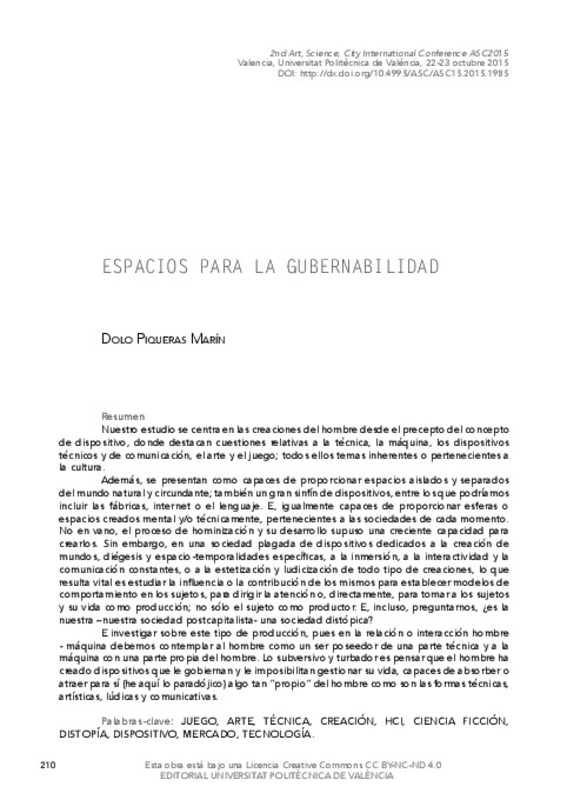JavaScript is disabled for your browser. Some features of this site may not work without it.
Buscar en RiuNet
Listar
Mi cuenta
Estadísticas
Ayuda RiuNet
Admin. UPV
ESPACIOS PARA LA GUBERNABILIDAD
Mostrar el registro sencillo del ítem
Ficheros en el ítem
| dc.contributor.author | Piqueras Marín, Mª Dolores
|
es_ES |
| dc.date.accessioned | 2018-01-31T12:33:45Z | |
| dc.date.available | 2018-01-31T12:33:45Z | |
| dc.date.issued | 2015-11-17 | |
| dc.identifier.isbn | 9788490484562 | |
| dc.identifier.uri | http://hdl.handle.net/10251/96307 | |
| dc.description.abstract | [EN] The focus of this research is the study of the human creations from the device concept point of view. To that effect issues related to technic, machine, communication and technical devices, art and the game are broached; all of them inherent or part of the culture. Technic, game and art, all of them are basically capable to produce spaces, aisles and separated from the natural world and surrounding to the human; also an endless number of devices, and we can include factories, internet or the language among them. All of them are capable to provide spheres or spaces created mental and/or technically, belonging to the human and its current society. Not for nothing, the hominization process and development implied an increased capacity to create them. Howbeit, it’s in a society riddled with devices devoted to the creation of worlds, specific storytelling and space-time, immersion, constant interactivity and communication or the aesthetization and gamification of any kind of creations, the critical point is to study its influence or contribution in establish behaviour models over the subjects, to drive the focus or, directly, to grab the subjects and their lives as a production; not only the subject as productor. And even ask, is our postcapitalist society a dystopian society? And investigate that kind of production, because in the relationship or interaction human-machine we must to observe to the human as a being holder of a technical share, and the machine as a holder of a human share. It’s subversive and disturbing to think the human has created devices that ruled him and incapacitate to manage his life, capable to absorb and bond itself (hereby the paradox) the humankind of the technical, artistic, recreational and communicative ways. | es_ES |
| dc.description.abstract | [ES] Nuestro estudio se centra en las creaciones del hombre desde el precepto del concepto de dispositivo, donde destacan cuestiones relativas a la técnica, la máquina, los dispositivos técnicos y de comunicación, el arte y el juego; todos ellos temas inherentes o pertenecientes a la cultura. Además, se presentan como capaces de proporcionar espacios aislados y separados del mundo natural y circundante; también un gran sinfín de dispositivos, entre los que podríamos incluir las fábricas, internet o el lenguaje. E, igualmente capaces de proporcionar esferas o espacios creados mental y/o técnicamente, pertenecientes a las sociedades de cada momento. No en vano, el proceso de hominización y su desarrollo supuso una creciente capacidad para crearlos. Sin embargo, en una sociedad plagada de dispositivos dedicados a la creación de mundos, diégesis y espacio-temporalidades específicas, a la inmersión, a la interactividad y la comunicación constantes, o a la estetización y ludicización de todo tipo de creaciones, lo que resulta vital es estudiar la influencia o la contribución de los mismos para establecer modelos de comportamiento en los sujetos, para dirigir la atención o, directamente, para tomar a los sujetos y su vida como producción; no sólo el sujeto como productor. E, incluso, preguntarnos, ¿es la nuestra –nuestra sociedad postcapitalista- una sociedad distópica? E investigar sobre este tipo de producción, pues en la relación o interacción hombre - máquina debemos contemplar al hombre como un ser poseedor de una parte técnica y a la máquina con una parte propia del hombre. Lo subversivo y turbador es pensar que el hombre ha creado dispositivos que le gobiernan y le imposibilitan gestionar su vida, capaces de absorber o atraer para sí (he aquí lo paradójico) algo tan “propio” del hombre como son las formas técnicas, artísticas, lúdicas y comunicativas | es_ES |
| dc.format.extent | 9 | es_ES |
| dc.language | Español | es_ES |
| dc.publisher | Editorial Universitat Politècnica de València | es_ES |
| dc.relation.ispartof | Actas Segundo Congreso Internacional Arte Ciencia Ciudad ACC2015 | es_ES |
| dc.rights | Reconocimiento - No comercial - Sin obra derivada (by-nc-nd) | es_ES |
| dc.subject | Juego | es_ES |
| dc.subject | Arte | es_ES |
| dc.subject | Técnica | es_ES |
| dc.subject | Creación | es_ES |
| dc.subject | HCI | es_ES |
| dc.subject | Ciencia ficción | es_ES |
| dc.subject | Distopía | es_ES |
| dc.subject | Dispositivo | es_ES |
| dc.subject | Mercado | es_ES |
| dc.subject | Tecnología | es_ES |
| dc.subject | Game | es_ES |
| dc.subject | Art | es_ES |
| dc.subject | Technique | es_ES |
| dc.subject | Creation | es_ES |
| dc.subject | Science fiction | es_ES |
| dc.subject | Dystopia | es_ES |
| dc.subject | Device | es_ES |
| dc.subject | Market | es_ES |
| dc.subject | Technology | es_ES |
| dc.title | ESPACIOS PARA LA GUBERNABILIDAD | es_ES |
| dc.type | Capítulo de libro | es_ES |
| dc.type | Comunicación en congreso | es_ES |
| dc.rights.accessRights | Abierto | es_ES |
| dc.description.bibliographicCitation | Piqueras Marín, MD. (2015). ESPACIOS PARA LA GUBERNABILIDAD. En Actas Segundo Congreso Internacional Arte Ciencia Ciudad ACC2015. Editorial Universitat Politècnica de València. 210-218. http://hdl.handle.net/10251/96307 | es_ES |
| dc.description.accrualMethod | OCS | es_ES |
| dc.relation.conferencename | 2º Congreso Internacional ACC: Arte, Ciencia, Ciudad | es_ES |
| dc.relation.conferencedate | October 22-23,2015 | es_ES |
| dc.relation.conferenceplace | Valencia, Spain | es_ES |
| dc.relation.publisherversion | http://ocs.editorial.upv.es/index.php/ASC/ASC15/paper/view/2041 | es_ES |
| dc.description.upvformatpinicio | 210 | es_ES |
| dc.description.upvformatpfin | 218 | es_ES |
| dc.type.version | info:eu-repo/semantics/publishedVersion | es_ES |
| dc.relation.pasarela | OCS\2041 | es_ES |






